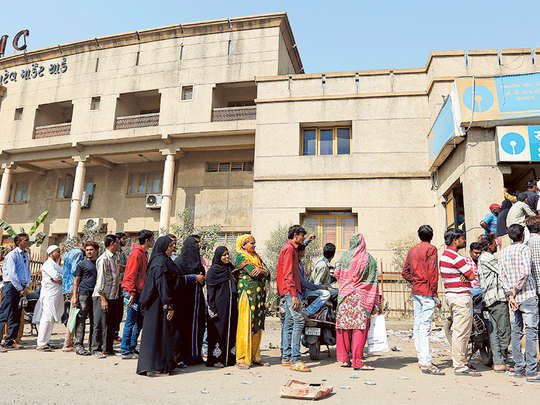
Dubai: The heavy flooding of liquidity into India’s banking system following the government’s announcement of withdrawal of Rs500 and Rs1000 notes are proving to be a costly luxury for Indian banks without any tangible benefits.
The banks together collected more than $120 billion (Dh440.4 billion) in new deposits following the demonetisation move the government announced on November 8. Following a mad rush to deposit the obsolete notes, banks witnessed a massive surge in their liquidity.
Alarmed by the excess liquidity in the banking system, the Reserve Bank of Inida (RBI, India’s central bank) has asked banks to temporarily maintain additional average daily balance with it in order to drain out the surplus liquidity with them.
“On the increase net demand and time liabilities between September 16 and November 11, scheduled banks shall maintain an incremental cash reserve ratio (CRR) of 100 per cent, effective the fortnight beginning November 26, 2016,” the RBI said in a recent circular.
The RBI said it will review the decision on December 9 or earlier as the incremental CRR, or a portion of deposits that banks have to maintain with the central bank, is intended to be a temporary measure within RBI’s liquidity management framework to drain excess liquidity in the system. The regular CRR would continue to be at 4 per cent.
Temporary measure
The RBI observed that following the demonetisation decision, there has been a surge in deposits relative to the expansion in bank credit, leading to large excess liquidity in the system. It assessed that the magnitude of surplus liquidity available with the banking system is expected to increase further in the fortnights ahead. “In view of this, it has been decided to absorb a part of this surplus liquidity by applying an incremental CRR as a purely temporary measure,” RBI said in a circular.
The RBI decision has come as a rude shock to many banks which expected the excess liquidity would ease the cost of funding and eventually increase lending at lower costs.
Faced with liquidity comfort, major lenders, including ICICI and HDFC Bank, lowered fixed deposit (FD) rates by up to 0.25 per cent. Many expected this move to be followed by a cut in lending rates in the weeks ahead.
Although the incremental CRR is to be reviewed during this week, many bankers feel they have been left with the task of mopping up liquidity from the public amid massive shortage of smaller denomination notes but were not given the opportunity to retain some share of the deposits collection involving huge administrative costs.
Pressure on banks’ earnings
“We do think that the banks need to be compensated for this loss,” Arundhati Bhattacharya, chairman of State Bank of India, told the Indian television station CNBC-TV18. “We are hoping that this is a temporary measure and that subsequently we will be given something.”
Analysts expect the collection of deposits and exchange of demonetised notes are expected cost banks about $15 billion per month. With little gain from the additional liquidity that flooded into their balance sheet, lenders admit that, the stand to lose from the whole exercise in the near term.
“The liquidity measure will put pressure on banks’ earnings as it will likely push up bond yields, Sushant Kumar, a fund manager at Mumbai-based Raay Global Investments Pvt, said. “Indian stocks may remain range bound with a negative bias in the short term” amid concerns of a slowdown in economic growth, he said.
Although the government’s demonetisation has faced mixed reactions from the public, the continuing cash shortage across the country is exerting huge pressure on banking operations across the country in terms of costs and resources












